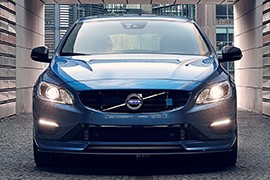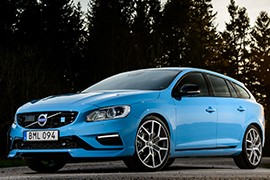VOLVO V60 Polestar Models/Series Timeline, Specifications & Photos
First production year: 2013
Engines: Gasoline
Body style: Wagon (station wagon, estate, combi, touring)
The Polestar was for Volvo like AMG for Mercedes-Benz or M for BMW. It was their division of mad engineers that tuned and tricked Volvo vehicles.
While it was still under Ford's ownership, Volvo had to do safe, soccer-mom, eco-friendly vehicles. They were not allowed to brag about their victorious racing past. Volvo could only show their automatic braking systems, the gazillion airbags, and its Swedish steel superiority. Well, Geely changed all that philosophy after Volvo passed through some hands and landed on the Chinese giant portfolio. The new owner tried to make Volvo fans smile again, and the Polestar versions were just a way to do that.
From the outside, the V60 Polestar sported a way more aggressive stance than its regular versions. The design team added a new lip-spoiler, a roof spoiler, and a diffuser under the rear bumper for starters. A pair of big exhaust was far from any ecological statement but quite convincing for anyone who wants to go faster. To complete the image of the bad guy of the family, Volvo installed 20" light-alloy wheels.
The Polestar version was similar to its V60 siblings, but it featured a different trim on the center console, which featured carbon-fiber accents. Its bucket-seats with high bolstering had blue stitching, the official color of the Polestar.
The 2017 version sported a 2.0-liter inline-four engine. A turbocharger and a supercharger helped it obtain 367 hp, which went to an 8-speed automatic transmission that sent the power to an electronically controlled all-wheel-drive system biased to the rear axle.
Many people knew Volvo as a safe, soccer-mom vehicle suitable for school runs and weekend shopping, especially in the long-roof version, such as the V60, but only a few people knew that the V60 Polestar was a factory-made sleeper.
While some would expect most premium automakers to produce powerful wagons, such as the BMW M5 or the Mercedes-AMG E63 T-Model, just a few believed that Volvo could join the bandwagon with the V60 Polestar. That was a blue vehicle built on top of a regular V60, but there were over 240 components replaced so the vehicle could perform like a sportscar.
Polestar was Volvo's sporty team, and their brand color was light blue. That's why all V60 Polestar wore the same shade on the outside. In addition, at the front, there was a different lower bumper than on the rest of the V60 range, with a honeycomb mesh grille in the apron and unique canards. Apart from the large 20" light-alloy wheels, there were no other differences in the car's profile, while at the back, the tailgate sported a roof spoiler at the top. Finally, a pair of pipes flanked the rear diffuser under the bumper.
Inside, the V60 Polestar received carbon-fiber trims on the center stack and center console. In addition, drivers could enjoy the aluminum pedals. Since it was the top-spec version for the V60, it featured a leather-wrapped interior that covered not only the seats and rear bench but also the door cards. As expected for a performance wagon, the automaker installed high-bolstered front seats that could keep their occupants in place during high-speed cornering maneuvers.
Under the hood, there was a transversely-mounted inline-six turbocharged powerplant paired with a six-speed automatic gearbox. Power went into all corners, and, most unusually, the V60 Polestar featured a launch-control function. In 2016, the inline-six was replaced by a turbocharged inline-four.

